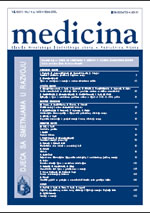
|
Medicina
Croatian Medical Association - Rijeka branch
ISSN: 0025-7729
Vol. 45, No. 2, 2009, pp. 154-159
|
 Bioline Code: me09020
Bioline Code: me09020
Full paper language: Croatian
Document type: Research Article
Document available free of charge
|
|
|
Medicina, Vol. 45, No. 2, 2009, pp. 154-159
| en |
Ecology, Host and Vectors of Francisella Tularensis
Semić, Vildana; Brezovec, Martin; Lazarić, Iva & Šantić, Marina
Abstract
Francisella tularensis is a gram-negative facultative intracellular bacterium that can cause a fatal disease, tularaemia, in human and animals. Francisella tularensis survives for months on very low temperatures, in water, mud or dead animals. If stored on –70° C or
lyophilized, virulence can be kept for years. It can also survive heating up to 42-65° C after food or water processing. Francisella tularensis is an intercellular parasite able to infect a great number of cell types while the macrophages are considered as the key cells for manifestation of the disease in humans. There are four subtypes of Francisella tularensis: tularensis (type A), holartica (type B), mediastatica and novicida. F. tularensis type A is found only in North America and is highly virulent. F. tularensis type B is less virulent for humans, and exists in North America and Europe. F. tuleransis subsp. holartica is less virulent, especially for humans, because its dissemination is slow and it causes a mild state of illness. F. tuleransis subsp. mediastatica has unique biochemical characteristics and is isolated only in Kazakhstan and Turkmenistan in central Asia, and shows virulence for organism similar to F. tuleransis type B. The primary reservoir of tularaemia are mammals like rabbits and other
rodents while the vector of disease are flies and mosquitoes. The bacteria can enter the organism by different routs of infection and the clinical symptoms of the disease depend on these entry.
Keywords
intracellular pathogen, tularaemia, zoonosis
|
| |
| hr |
Ekologija, domaćini i vektori bakterije Francisella tularensis
Semić, Vildana; Brezovec, Martin; Lazarić, Iva & Šantić, Marina
Francisella tularensis aerobna je, nesporogena, gram-negativna fakultativna unutarstanična bakterija koja u ljudi i životinja uzrokuje smrtonosnu bolest tularemiju. Francizele mogu preživjeti mjesecima na niskoj temperaturi, u vodi, blatu ili leševima životinja. Ako
se pohrane na -70˚C ili se liofi liziraju, virulenciju mogu zadržati godinama. Također mogu preživjeti zagrijavanje na temperaturama od 42 – 65˚C, te u hrani i vodi za piće. F. tularensis je unutarstanični parazit i sposobna je inficirati veliki broj staničnih tipova od kojih su glavni makrofagi za razmnožavanje in vivo. Postoje četiri podvrste F. tularensis: tularensis (tip A), holartica (tip B), mediasiatica i novicida. F. tularensis tip A nalazi se samo u Sjevernoj Americi i uzročnik je visoko virulentan. F. tularensis tip B je manje virulentan za zečeve, ali i za ljude, a postoji u Sjevernoj Americi i Europi. F. tularensis subsp. holartica je manje virulentna, osobito za ljude jer je diseminacija sporija i uzrokuje lakši oblik bolesti. F. tularensis subsp. mediasiatica ima jedinstvene biokemijske osobine i izolirana je samo u Kazahstanu i Turkmenistanu u središnjoj Aziji, te pokazuje virulenciju za organizme slične kao F. tularensis tip B. Primarni
rezervoar tularemije su zečevi i glodavci, a vektori bolesti muhe i komarci. Uzročnik može ući u organizam na više načina i mjesta, pa tako klinička slika bolesti može biti različita.
intracelularni parazit, tularemija, zoonoza
|
| |
© Copyright © 2008 - Croatian Medical Association - Rijeka branch
Alternative site location: http://hrcak.srce.hr/medicina
|
|
